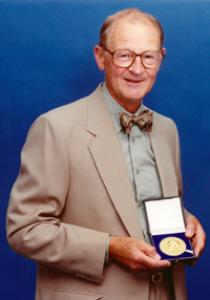
Richard White was a pioneer in paediatric nephrology in the UK and internationally, and a founder and the first president of the British Association for Paediatric Nephrology (BAPN).
He was the youngest of three children born to Sydney and Marion White in Newcastle under Lyme. His father and uncle ran a ladies and gentlemen's outfitters, and his mother was a school teacher. He went to Newcastle under Lyme High School, followed by Emmanuel College Cambridge and Guy’s Hospital, where he qualified in medicine in 1950.
His first paediatric appointment was in Bath, followed by a period at Great Ormond Street Hospital for Children (GOS) in London. During his training he became interested in nephrotic syndrome in children. First recognised by Richard Bright of Guy’s Hospital in 1827, it was still known in the 1950s as Bright’s disease, and there remained a dearth of information about its accurate diagnosis, and even less about treatment. In adults with kidney disease, during the 1950s the importance of pathological change in the kidney had been recognized and methods developed for obtaining a renal biopsy, first by open biopsy then using biopsy needles. At GOS, White was encouraged by Alan Moncrieff to do liver biopsies, and then learned of renal biopsy in adults from Hugh de Wardener. He immediately saw the potential if a biopsy needle could be developed specially for children.
At GOS in November 1959 he performed a needle renal biopsy under general anaesthesia, the first in Europe in a child. In 1960 he was seconded to Mulago Hospital in Kampala, Uganda returning in 1962. While there he did further development work on renal biopsy, including the design of his biopsy needle and the use of sedation rather than general anaesthesia. He established this technique when he returned to the Evelina Childrens Hospital at Guy’s Hospital. White trained himself to be an excellent morphologist, and reported all his own biopsies, as only a handful of pathologists would consider drawing conclusions from such small fragments of tissue at that time.
Whilst at Guy’s Hospital he formed a partnership with Stewart Cameron, and they set up parallel adult and paediatric units, sharing biopsy meetings. Between them they carried out a comprehensive study of all children with kidney disease in the South Thames region, doing renal biopsies at many hospitals in the region. This study drew international attention and was a springboard for the formation of the International Study of Kidney Disease in Children (ISKDC) in 1966, formed under the direction of Henry Barnett of the Albert Einstein Hospital, New York. ISKDC undertook seminal studies of glomerular disease in children in the 1970s and 1980s. All the biopsies in the ISKDC were reported by three referral pathologists - White, along with Renée Habib (France) and Jacob Churg (USA), leaders in the field. ISKDC transformed understanding of the histopathology and treatment of glomerular disease in children, and defined the role of renal biopsy in management, as well as promoting clinical trials of treatment.
In 1965 White was appointed to Birmingham Children’s Hospital as Senior Lecturer to establish a children’s renal unit. He became an honorary Consultant in 1985, and in 1986 was made Professor. His legacy at Guy’s was a world-famous paediatric nephrology unit, run by adult nephrologists, Cameron and Dr Chisholm Ogg with the general paediatricians of the Evelina, until the appointment of (Professor Sir) Cyril Chantler in 1970. White was early to recognise the need for a comprehensive renal service in Birmingham, covering all aspects of clinical nephrology, and including provision of dialysis and renal transplantation. Resources were scarce, and he engaged the help of Mrs Elizabeth Ward, founder of the British Kidney Patients Association, whose generosity helped him to provide services for renal failure in children throughout the West Midlands. But only in 1997, after his retirement, was the goal of a fully comprehensive service achieved.
White helped found the Birmingham Reflux Study group and published a number of papers on urinary infection and related topics. But his main interest remained renal histology in childhood. As well as studies of glomerular pathology, he also measured the thickness of the glomerular basement membrane throughout childhood and studied the effects of nephron loss in promoting scarring.
White had a sense of history. He found the 150-year-old specimens in Guys Hospital Pathology museum from Bright’s original cases and defined their pathology using modern techniques. In 2003 he wrote a history of the first thirty years of the British Association for Paediatric Nephrology (BAPN). He had been a founder member of BAPN in 1973 becoming its President in 1991-1994. He was also a founder member of the European Society for Paediatric Nephrology in 1967.
All who worked with him in research recognised his scientific integrity, thoughtfulness and meticulous attention to detail; qualities equally important for his excellent clinical practice. Neither by nature, nor in his speaking and writing was he a flamboyant or media-seeking man, but he achieved much for children with kidney disease using his own gifts. In every sense, he was a gentleman, courteous, fair and when necessary, steadfast although he sometimes seemed troubled by the ways of the world. He was good with children and their parents and well respected by his colleagues.
In 1995 he was awarded the James Spence medal given annually by the British Paediatric Association, now the Royal College of Paediatrics and Child Health, for outstanding contributions to Child Health. This, he thought, was the highlight of his career.
He married Patricia Taverner, a nurse, in 1952 and they raised two boys. He loved to travel and was a keen and observant photographer. He loved music, and in retirement, he took up the exacting craft of water-colour painting. Gardening was another passion, and over his lifetime he created three beautiful gardens. He played tennis with Patricia well into his retirement; she predeceased him in 2018. He is survived by their two sons.